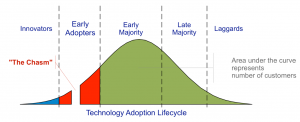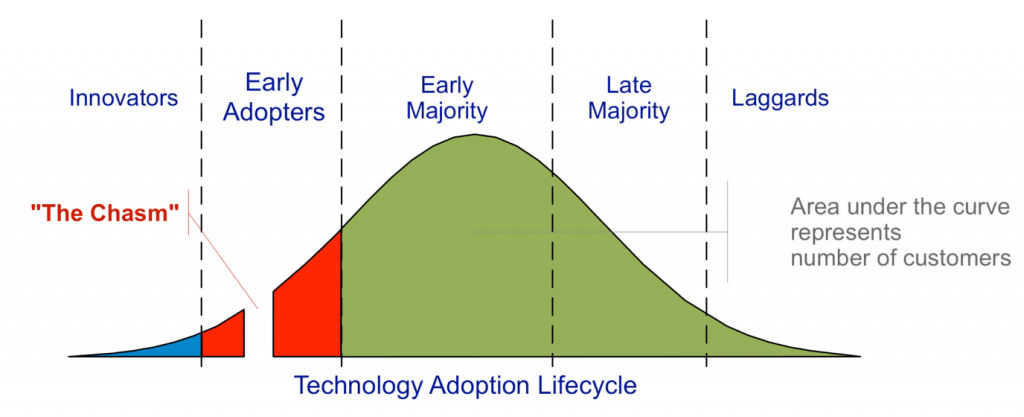At Early Adopter Research, we believe that IT, the application of technology to solve business problems, is one of the most important areas of human endeavor, one that can create massive value and solve some of the world’s most vexing problems.
This article is the first of several that Early Adopter Research, which we call EAR, will publish to define the mindset we recommend that enables technology to become a massive lever to increase an organization’s performance.
Our goal is to provide ways to get ahead and stay ahead; to create sustainable advantage. For that reason, we are focused Early Adopters, those people on the left most side of the chasm as defined by Geoffrey Moore’s Crossing the Chasm framework that divides the world of technology adopters into five categories:

For those who are not familiar with this framework, here are the way each category is described:
- Innovators, the engineering rich companies with special needs for advanced capabilities, who often must build their own technology. These companies — like Google, Amazon, Facebook, and other firms — must invent or heavily adapt tech to meet their needs.
- Early Adopters, who are seeking to apply technology that is coming into a more defined state. We define the chasm in the middle of this category. This group, especially the segment on the right side of the chasm, would much rather use productized, stable technology to solve a problem than build it.
- The Early Majority, who are looking for proven technology that fits into well-defined use cases.
- The Late Majority, who want widely used, low risk solutions.
- The Laggards or Skeptics, who only use what they have to, and take great delight in pointing out that often the promises made about technology and products often fall short of reality.
Early Adopters, the heroes of our mindset, are those technology and business leaders who are looking to innovate, to be the first to understand and adopt powerful new technology products, and most of all, to design and implement product-based platforms.
For the record, much of the world defines the chasm as between the Early Adopters and the Early Majority. In my view, there is a segment of the market that is legitimately interested in innovation, but is also seeking to use products and stable open source projects. These are the people who, in our view at EAR, create the most value for the organizations they serve because they adopt technology products early and create differentiation at an affordable cost.
Use Value Versus Vendor Value
Much of the world of technology journalism focuses on the earnings of technology companies. Did Apple or IBM or Oracle or Dell or whoever make their revenue numbers? Did the CEO get dumped? Did one company buy another?
In other words, technology journalism focuses on the vendor value, which is created by the money paid by technology users to the vendor. As a result, technology journalism is essentially about money, funding and earnings, and also corporate events. Products, when they are mentioned, are described only in very high level terms.
It wasn’t always this way. In the past, with more advertising dollars paying the bills, the trade press offered more coverage about how products worked. Excellent magazines like Datamation provided a coverage that combined aspects of The Economist and the New Yorker. Today, we can find such articles scattered over a broad landscape of publications like TheRegister.co.uk, Wired, to some extent, and lots of blogs and podcasts.
But products are the engines of value in IT. What is missing from this coverage is the way that the use value is created.
Let’s say a big company that has a key problem to solve. The firm might spend $5 million on licenses and infrastructure and another $5 to $10 million or so on services to do the implementation. Let’s say the project is to reduce Days Sales Outstanding. It is not unusual for a project like this to have returns of $20, $30, $50 million in the first year, and the same or more every year after that. This is the use value of technology, the value created by putting technology to work.
It is the massive returns from use value that keep the Global Systems Integrators in business. Large companies are happy to pay massive fees to get 5x or 10x returns.
At EAR, our focus is use value. How do technology products get integrated with the people and products to create those 5x and 10x returns. Usually, such victories are complex melange of deep understanding of a business, excellent change management, some high-skill software development and integration, and an inspired use of many technology products working together.
We feel that by covering how to create use value in the Research Missions we pursue, we will be able to start and lead conversations worth observing and joining.
Early Adopters and Product Focus
The product focus is a key to our theory of how technology creates value. Our research mission on Technology Leverage explains how Ray Kurzweil’s theory of the exponential progress of technology relates to enterprise software.
Technology creates increasing value exponentially for three reasons:
- First, low level services are developed and then are used to create more powerful higher level services.
- Second, the higher level services evolve based on usage and enjoy a better fit to purpose.
- Third, investment is targeted toward areas that are the most promising.
This cycle has played itself out over many generations. What is key is the definition of the product. Early Adopters are looking for products that have simplified the delivery of complex tasks.
The scope of a product must be substantial. A large and important problem must be solved in a way that provides leverage. That’s why Steve Jobs used this technology put down when a product was too narrow: That’s not a product, it’s a feature.
Almost all of today’s enterprise products, even those in early stages, are really platforms: many capabilities knit together to solve a problem.
But it can be challenging to understand what a product does. Our goal is to help Early Adopters understand products and how many products can be fit together into a product-based platform.
The Rewards of a Product-based Platform
When the fit to purpose is good, and complementary products are combined in ways to amplify each other’s capabilities, this structure that is able to create massive value for several reasons:
- The license cost of the products are generally much lower than the cost of developing the capabilities.
- The degrees of freedom in the products allow them to be adapted to meet the needs of an organization.
- The operating costs is lower than development of custom software.
When a product-based platform succeeds in solving a key business problem, a whole bunch of skills have been developed and a deep understanding of how to use many product emerges. This understand along with the change management skills and the credibility of a victory opens the door for the platform to grow and solve new problems.
Caveats
This all sounds good, but as we know, a lot can go wrong. Here are some of the mistakes that can emerge in this journey:
- The products can be buggy and problematic. Early stage products or emerging open source often have defects that must be addressed. Sometimes these can be fatal to the implementation of a product-based platform.
- The product fit can seem better than it is. Sometimes during implementation, certain capabilities are needed that should be there, or will be there, but don’t work now.
- The amount of integration needed is overwhelming. There will be integration work in any product-based platform, but if this work becomes a full-scale development project, then the goal of the product-based platform is not being achieved. That said, it is often the case that after a product-based platform is successful, the development of key additional capabilities becomes much easier to justify because the ROI is well understood.
At EAR, our goal is to determine how to design product-based platforms to solve problems defined in our Research Missions to create the most possible use value. This is our kind of fun.

